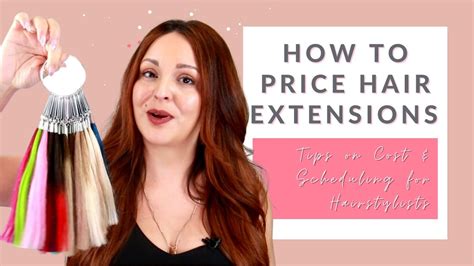Hair Extensions: A Luxury at a Price
The allure of luscious, flowing locks has made hair extensions a popular choice for women seeking to enhance their beauty. However, the cost of hair extensions can vary significantly depending on factors such as the type of hair, the method of application, and the salon’s location.

Types of Hair Extensions
1. Synthetic Hair Extensions:
- Cost: $100-$300 per full head
- Pros: Affordable, easy to style, and widely available.
- Cons: Not as natural-looking as human hair, prone to tangling and matting.
2. Human Hair Extensions:
- Cost: $400-$1,500 per full head
- Pros: Natural-looking, blends seamlessly with natural hair, versatile styling options.
- Cons: More expensive than synthetic hair, requires professional installation.
3. Remy Hair Extensions:
- Cost: $600-$2,000 per full head
- Pros: Highest quality human hair, cuticles aligned in the same direction, minimizes tangling.
- Cons: Most expensive option, limited color selection.
Methods of Hair Extension Installation
1. Clip-In Hair Extensions:
- Cost: $100-$300 per set
- Pros: Easy to install and remove, temporary option.
- Cons: Visible clips, not suitable for thin or short hair.
2. Tape-In Hair Extensions:
- Cost: $300-$600 per full head
- Pros: Semi-permanent, blends well with natural hair.
- Cons: Requires professional installation and removal, can be damaging to hair.
3. Fusion Hair Extensions:
- Cost: $500-$1,200 per full head
- Pros: Permanent, long-lasting, creates volume and length.
- Cons: Damages hair during installation, requires professional maintenance.
4. I-Tip Hair Extensions:
- Cost: $700-$1,500 per full head
- Pros: Micro-beaded, creates natural-looking volume.
- Cons: Time-consuming to install, requires regular maintenance.
Salon Location and Pricing
The cost of hair extensions can also vary depending on the salon’s location and reputation. Salons in major cities or those with experienced stylists typically charge higher prices.
Factors to Consider When Calculating Cost
- Length: Longer extensions require more hair and labor, resulting in higher costs.
- Density: Thicker extensions require more hair, increasing the cost.
- Color: Custom colors require additional processing, which can add to the price.
- Maintenance: Regular maintenance costs, such as trims and re-tightening, should be factored into the overall budget.
Beyond the Cost: Value and Benefits
While the cost of hair extensions is an important consideration, it’s also crucial to assess their value and benefits:
- Increased Confidence: Hair extensions can dramatically improve self-esteem and confidence.
- Versatile Styling Options: They allow for endless possibilities, from sleek ponytails to voluminous curls.
- Time-Saving: Saves time spent on styling and detangling unruly hair.
- Hair Health: Can protect fragile hair from damage and breakage.
- Special Occasions: Perfect for special events where you want to make a statement.
Pros and Cons of Hair Extensions
Pros:
- Enhance length, volume, and color
- Improve self-image
- Versatility in styling
- Temporary or permanent options
Cons:
- Can be expensive
- May damage hair if not installed properly
- Require maintenance and upkeep
- Not suitable for all hair types
Tables for Further Reference
| Extension Type | Installation Method | Cost | Pros | Cons |
|---|---|---|---|---|
| Synthetic | Clip-In | $100-$300 | Affordable, easy to install | Not natural-looking, prone to tangling |
| Human Hair | Tape-In | $300-$600 | Semi-permanent, blends well | Requires professional installation, can be damaging |
| Remy Hair | Fusion | $500-$1,200 | Permanent, long-lasting | Damages hair during installation, requires maintenance |
| Remy Hair | I-Tip | $700-$1,500 | Natural-looking volume, micro-beaded | Time-consuming to install, requires regular maintenance |
| Salon Location | Cost Variation |
|---|---|
| Major City | Higher prices for skilled stylists |
| Suburb | Lower prices but fewer experienced stylists |
| Rural Area | Lowest prices but limited availability |
| Factors Affecting Cost | Possible Impacts |
|---|---|
| Length | Longer extensions increase hair and labor costs |
| Density | Thicker extensions require more hair |
| Color | Custom colors require additional processing |
| Maintenance | Regular upkeep adds to the overall budget |
Embracing the “Hairitage”
In the realm of beauty, hair extensions have emerged as a transformative tool, allowing individuals to express their personal style and embrace their “hairitage.” The diverse range of options available empowers women to create their desired look, whether it’s sleek and sophisticated or voluminous and glamorous.
While the cost of hair extensions can be a consideration, it’s important to weigh the value and benefits they offer. By understanding the factors that influence pricing and exploring the various options available, individuals can make informed decisions that align with their beauty aspirations and budget.
Frequently Asked Questions
Q: How long do hair extensions last?
A: The lifespan of hair extensions depends on the type and maintenance. Synthetic hair extensions typically last 3-6 months, while human hair extensions can last up to 12 months with proper care.
Q: Can hair extensions damage my hair?
A: Yes, improper installation or excessive weight can damage natural hair. It’s crucial to consult with a professional stylist to minimize risks.
Q: What are the best types of hair extensions for thin hair?
A: Tape-in or I-tip hair extensions are ideal for thin hair as they distribute weight evenly and create volume without adding bulk.
Q: How can I save money on hair extensions?
A: Consider synthetic hair extensions, opt for temporary clip-in options, or choose a salon in a less expensive location.
